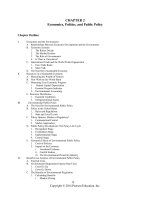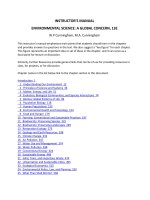Test bank and solution manual developing successful organisational (2)
Bạn đang xem bản rút gọn của tài liệu. Xem và tải ngay bản đầy đủ của tài liệu tại đây (2.37 MB, 61 trang )
Chapter 02 - Developing Successful Organizational and Marketing Strategies
CHAPTER CONTENTS
PAGE
POWERPOINT RESOURCES TO USE WITH LECTURES..........................................2-2
LEARNING OBJECTIVES (LO) ......................................................................................2-4
KEY TERMS ......................................................................................................................2-4
LECTURE NOTES
•
Chapter Opener: Starting a Business by Getting an “A” in an Ice Cream Making
Course!.....................................................................................................................2-5
•
Today’s Organizations (LO 2-1) ...............................................................................2-6
•
Strategy in Visionary Organizations (LO 2-2; LO 2-3) ............................................2-10
•
Setting Strategic Directions (LO 2-4) .......................................................................2-19
•
The Strategic Marketing Process (LO 2-5; LO 2-6; LO 2-7) ...................................2-26
APPLYING MARKETING KNOWLEDGE....................................................................2-35
BUILDING YOUR MARKETING PLAN........................................................................2-39
VIDEO CASE (VC)
•
VC-2: IBM: Using Strategy to Build a “Smarter Planet”...........................................2-43
APPENDIX D CASE (D)
•
D-2: Daktronics, Inc.: Global Displays in 68 Billion Colors .....................................2-48
IN-CLASS ACTIVITIES (ICA)
•
ICA 2-1: Calculating a “Fog Index” for Your Own Writing......................................2-52
•
ICA 2-2: Marketing Yourself....................................................................................2-56
2-1
Chapter 2
Copyright © 2015 McGraw-Hill Education. All rights reserved. No reproduction or distribution without the prior written consent of McGraw-Hill Education.
Chapter 02 - Developing Successful Organizational and Marketing Strategies
POWERPOINT RESOURCES TO USE WITH LECTURES1
PowerPoint
Slide2
Textbook Figures
Figure 2-1 The board of directors oversees the three levels of strategy in organizations:
corporate, business unit, and functional (p. 27)..................................................................2-8
Figure 2-2 Visionary organizations: (1) establish a foundation, (2) set a direction, and
(3) create strategies to successfully develop and market their offerings (p. 29) ........... 2-11
Figure 2-3 An effective marketing dashboard like Sonatica’s helps managers assess a
business situation at a glance (p. 33) ................................................................................ 2-22
Figure 2-3A
Figure 2-3B
Figure 2-3C
Marketing Dashboard: Website Traffic Sources........................................................... 2-23
Marketing Dashboard: Sales Performance by SBU...................................................... 2-24
Marketing Dashboard: Monthly Website Visits by State............................................. 2-25
Figure 2-4 Boston Consulting Group business portfolio analysis for Apple’s consumer-related
SBUs starting in 20913 and projected for 2016 (p. 37) .................................................. 2-32
Figure 2-5 Four alternative market-product strategies for Ben & Jerry’s to expand sales
revenues using diversification analysis (p. 38)................................................................ 2-34
Figure 2-6 The strategic marketing process has three phases: planning, implementation,
and evaluation (p. 40) ......................................................................................................... 2-36
Figure 2-7 Ben & Jerry’s SWOT analysis that serves as the basis for management actions
regarding growth (p. 41) ................................................................................................... 2-39
Figure 2-8 The 4 Ps elements of the marketing mix must be blended to produce a cohesive
marketing program (p. 42) ................................................................................................ 2-44
Figure 2-9 Organization of a typical manufacturing firm, showing a breakdown of the
marketing department (p. 43)............................................................................................ 2-46
Figure 2-10 Gantt chart for scheduling a term project that distinguishes sequential and
concurrent tasks [p. 44] ..................................................................................................... 2-50
Figure 2-11 The evaluation phase requires Apple to compare actual results with goals to
identify and act on deviations to fill in the “planning gap” by 2012 (p. 45) ................. 2-52
Selected Textbook Images (Ads, People, Products, and Websites)
Chapter Opener: Image of Ben & Jerry’s social mission statement (p. 25) ..........................................2-4
Photos of Apple’s iPad/iPad mini (Tablets), iPod (MP3 Players), iPhone (Smartphones),
and MacPro/iMac/MacBook (Desktop/Laptop PCs): What SBU type in the BCG
growth-share matrix? (p. 37) ................................................................................................................. 2-30
Video Case VC-2: Photo of IBM’s logo and a print ad for IBM’s “Smarter Plant” (pp. 48-49) ...... 2-53
Using Marketing Dashboards with an Excel Spreadsheet
How Well is Ben & Jerry’s Doing?: Dollar Sales and Dollar Market Share (p. 34)
[See UMD02SalesMktShare.xls] ........................................................................................................... 2-26
1
2
For each PowerPoint resource listed, the page reference in the textbook (p. x) or [p. y] is where the figure or image is located.
The PowerPoint presentation (PPT) for this chapter is either available on the Instructor’s Resource CD-ROM or downloadable from the Marketing: 12/e website
at . The PPT slide number references are for this chapter only.
Chapter 2
2-2
Copyright © 2015 McGraw-Hill Education. All rights reserved. No reproduction or distribution without the prior written consent of McGraw-Hill Education.
Chapter 02 - Developing Successful Organizational and Marketing Strategies
POWERPOINT RESOURCES TO USE WITH LECTURES
Marketing Matters, Making Responsible Decisions, and/or Marketing inSite
PowerPoint
Slide
Making Responsible Decisions—Social Responsibility: Using Social Entrepreneurship to
Help People (p. 27) ..................................................................................................................................2-7
Marketing Matters—Entrepreneurship: Angry Birds: Discovering Its “Business” and …
Business Model! (p. 31)......................................................................................................................... 2-15
Marketing Matters—Technology: Filling the Shoes of Apple CEO Tim Cook: Where Will
Apple’s Projected Future Growth for Its Major SBUs Come From? (p. 36) ..................................... 2-31
Supplemental Image
Photo of the Starship Enterprise: Why is a mission statement important? [p. 29] ............................. 2-13
Supplemental Figures
Figure 2-A How an industry is structured [pp. 26-31] ..........................................................................2-6
Figure 2-B Elements in typical marketing and business plans targeted at different audiences
[pp. 30, 32] ......................................................................................................................... 2-20
Figure 2-C Intertype competition for Lands’ End [p. 35] ................................................................... 2-28
Figure 2-D Business portfolio analysis: BCG matrix [pp. 35-38] ...................................................... 2-29
Figure 2-E Tasks and time needed to complete a term project [p. 44] .............................................. 2-49
Quick Response (QR) Codes3
QR 2-1: Cree LED Bulb Ad (p. 26) .........................................................................................................2-5
QR 2-2: Medtronic Video (p. 29)........................................................................................................... 2-12
QR 2-3: Angry Birds Video (p. 31) ....................................................................................................... 2-15
QR 2-4: B&J’s Bonnaroo Buzz Ad (p. 38) ........................................................................................... 2-33
QR 2-5: IBM Video Case (p. 48) ........................................................................................................... 2-53
In-Class Activities (ICA)
ICA 2-1: Calculating a “Fog Index” for Your Own Writing [pp. 32, 51-52 of App. A].................... 2-59
ICA 2-2: ICA 2-2: Marketing Yourself [pp. 39-42] ............................................................................. 2-61
3
TV ads, videos, websites, and video cases with QR Codes can be viewed at . Please note that for QR codes, there MUST be the appropriate
QR Code reference (qr1-1, qr1-2, etc.) that follows the “/” after 12e.kerin.tv in the URL. So, to view QR 2-1, the proper URL is />
2-3
Chapter 2
Copyright © 2015 McGraw-Hill Education. All rights reserved. No reproduction or distribution without the prior written consent of McGraw-Hill Education.
Chapter 02 - Developing Successful Organizational and Marketing Strategies
LEARNING OBJECTIVES (LO)
After reading this chapter students should be able to:
LO 2-1: Describe three kinds of organizations and the three levels of strategy in them.
LO 2-2: Describe core values, mission, organizational culture, business, and goals.
LO 2-3: Explain why managers use marketing dashboards and marketing metrics.
LO 2-4: Discuss how an organization assesses where it is now and where it seeks to be.
LO 2-5: Explain the three steps of the planning phase of the strategic marketing process.
LO 2-6: Describe the four components of the implementation phase of the strategic marketing
process.
LO 2-7: Discuss how managers identify and act on deviations from plans.
KEY TERMS
business p. 30
marketing tactics p. 44
business portfolio analysis p. 35
mission p. 29
core values p. 29
objectives p. 31
diversification analysis p. 38
organizational culture p. 30
goals p. 31
points of difference p. 41
market segmentation p. 40
profit p. 26
market share p. 31
situation analysis p. 39
marketing dashboard p. 32
strategic marketing process p. 39
marketing metric p. 32
strategy p. 26
marketing plan p. 32
SWOT analysis p. 39
marketing strategy p. 44
Chapter 2
2-4
Copyright © 2015 McGraw-Hill Education. All rights reserved. No reproduction or distribution without the prior written consent of McGraw-Hill Education.
Chapter 02 - Developing Successful Organizational and Marketing Strategies
LECTURE NOTES
STARTING A BUSINESS BY GETTING AN “A”
IN AN ICE CREAM MAKING COURSE!
•
Ben & Jerry’s started in 1978 when friends Ben Cohen and Jerry Greenfield:
a. Had “aced” their $5 college correspondence course in ice cream making.
b. Invested $12,000 in a renovated Vermont gas station from borrowed/saved funds.
c. Concocted the universally best selling flavor—vanilla premium ice cream!
•
Ben & Jerry’s successfully implemented highly creative organizational and marketing
strategies, which include:
a. Caring Dairy. Buys milk products from a dairy cooperative that are bovine
growth hormone-free.
b. PartnerShops. Uses social entrepreneurship to:
•
Help community-based nonprofit organizations to…
•
Better the lives of at-risk youth and young adults by giving them jobs.
c. Fair Trade. Believes “people should get their fair share of the pie,” in which:
•
Ingredients (cocoa, vanilla, coffee) are Fair Trade-certified sourced from…
•
Producers in developing countries who practice sustainable farming.
d. B-Corp Certified. Received the honor from B-Lab because Ben & Jerry’s:
•
•
“Uses the power of business to solve social and environmental problems.”
•
Positively impacts the community and environment within which it operates.
Ben & Jerry’s three-part social mission links the form to social causes designed to:
a. Improve humanity.
b. Offer consumers delicious products with creatively funky names.
•
Ben & Jerry’s is now owed by Unilever.
•
Ben & Jerry’s:
a. Is the market leader in the global premium ice cream industry, which…
b. Is expected to reach $68 billion in sales by 2015.
c. Has over 7 million Facebook fans.
2-5
Chapter 2
Copyright © 2015 McGraw-Hill Education. All rights reserved. No reproduction or distribution without the prior written consent of McGraw-Hill Education.
Chapter 02 - Developing Successful Organizational and Marketing Strategies
•
Ben & Jerry’s and other organizations set goals to give an overall direction to their
organizational and marketing strategies.
•
Their marketing departments convert these goals into plans that are implemented and
then evaluated.
I. TODAY’S ORGANIZATIONS [LO 2-1]
In studying today’s visionary organizations, one must understand:
•
The kinds of organizations that exist.
•
What strategy is.
•
How strategy relates to the three levels of structure found in large organizations.
A. Kinds of Organizations
•
An organization is a legal entity of people who share a common mission.
•
This mission motivates organizations to:
a. Develop offerings, which are goods, services, or ideas that…
b. Create value for both the organization and its customers.
•
Organizations consist of three types:
a. For-profit organization.
•
Is often called a business firm.
•
Is a privately owned organization that…
•
Serves its customers in order to earn a profit, which is the:
•
–
Money left after a for-profit organization subtracts its total expenses
from its total revenues.
–
Reward for the risk it undertakes in marketing its offerings.
Must earn a profit to survive.
[QR Code 2-1: Cree LED Bulb Ad]
b. Nonprofit organization.
•
Chapter 2
Is a nongovernmental organization that…
–
Serves its customers but…
–
Does not have profit as an organizational goal.
2-6
Copyright © 2015 McGraw-Hill Education. All rights reserved. No reproduction or distribution without the prior written consent of McGraw-Hill Education.
Chapter 02 - Developing Successful Organizational and Marketing Strategies
•
Goals include operational efficiency or client satisfaction.
•
Examples: Charities and cooperatives.
MAKING RESPONSIBLE DECISIONS
Social Responsibility: Using Social Entrepreneurship to Help People
•
Teach for America and SightLife are examples of “social entrepreneurs.”
•
Social entrepreneurship.
a. Applies innovative approaches to…
b. Organize, create, and manage a venture to…
c. Solve the practical needs of society.
•
Social entrepreneurs:
a. Usually are nonprofit organizations.
b. Focus on issues facing people who lack the financial or political means to solve
their own problems.
•
Teach for America.
a. Is a national corps of recent college graduates who commit to teach for two years
in urban and rural public schools.
b. In 2013:
•
•
More than 10,000 corps members taught 750,000 students.
•
Nearly 28,000 alumni continue to work for the changes necessary to ensure
educational excellence and equity.
SightLife.
a. Has a mission “to end cornea blindness.”
b. Cornea blindness affects 10 million people globally, who can be cured by
transplanting a donated, healthy cornea to replace a diseased one.
c. SightLife works with eye surgeons and health organizations in about 30 countries.
d. SightLife provided more than 14,000 corneas for transplant.
2-7
Chapter 2
Copyright © 2015 McGraw-Hill Education. All rights reserved. No reproduction or distribution without the prior written consent of McGraw-Hill Education.
Chapter 02 - Developing Successful Organizational and Marketing Strategies
c. Government agency.
•
Is a federal, state, county, or city unit that…
•
Provides a specific service to its constituents.
•
Example: Census Bureau.
•
The terms firm, company, and organization are used interchangeably to cover
both for-profit and nonprofit organizations.
•
Organizations that develop similar offerings, when grouped together, create an
industry, such as the automobile industry or the ice cream industry.
a. [Figure 2-A] The dynamics of an industry and how it is structured impact the
strategic decisions organizations make.
b. These strategic decisions create a compelling and sustainable competitive
advantage to achieve superior performance for an organization’s offerings.
c. Organizations must understand the industry within which they compete.
B. What Is Strategy?
•
An organization has limited human, financial, technological, and other resources
available to produce and market its offerings—it can’t be all things to all people!
•
Strategy is an organization’s long-term course of action designed to deliver a
unique customer experience while achieving its goals.
a. All organizations set a strategic direction.
b. Marketing helps to set a strategic direction and to move the organization there.
C. The Structure of Today’s Organizations
[Figure 2-1] Large organizations are very complex and consist of three levels:
1. Corporate Level. Is the level in an organization where top management directs
overall strategy for the entire organization. Consists of:
a. Board of directors, individuals both inside and outside the organization.
b. Chief executive officer (CEO), the highest ranking officer in the organization.
Chapter 2
•
CEOs must possess leadership skills.
•
CEOs must have the expertise to:
–
Oversee the organization’s daily operations.
–
Spearhead its strategic planning efforts.
2-8
Copyright © 2015 McGraw-Hill Education. All rights reserved. No reproduction or distribution without the prior written consent of McGraw-Hill Education.
Chapter 02 - Developing Successful Organizational and Marketing Strategies
c. Chief marketing officer (CMO), who:
•
Develops and implements the organization’s strategy to achieve its goals.
•
Must think strategically to deliver value to the organization.
•
Must have:
•
–
Multi-industry backgrounds.
–
Analytical skills.
–
Cross-functional expertise.
–
Intuitive marketing insights.
Is often called upon to be their organization’s visionary.
2. Strategic Business Unit Level. Is the level in multimarket, multiproduct firms
where managers manage a portfolio or groups of businesses.
a. A strategic business unit (SBU) is a subsidiary, division, or unit of an
organization that markets a set of related offerings to a clearly defined target
market.
b. At the strategic business unit level, managers set a more specific strategic
direction for their businesses to exploit value-creating opportunities.
c. For firms with a single business focus like Ben & Jerry’s, the corporate and
business unit levels may merge.
3. Functional Level. Is the level in an organization where groups of specialists
actually create value for the organization.
a. A department refers to those specialized functions, such as marketing.
b. At this level, the strategic direction becomes more specific and focused.
c. A key role of the marketing department is to:
•
Listen to customers.
•
Develop offerings.
•
Implement marketing program actions.
•
Evaluation whether these actions achieved the organization’s goals.
d. Cross-functional teams:
•
Are formed by senior management to develop new or improve existing
offerings.
•
Consist of a small number of people from different departments…
•
Are mutually accountable to accomplish a task or common set of
performance goals.
•
Will sometimes have representatives from outside the organization, such
as suppliers and customers, to assist them.
2-9
Chapter 2
Copyright © 2015 McGraw-Hill Education. All rights reserved. No reproduction or distribution without the prior written consent of McGraw-Hill Education.
Chapter 02 - Developing Successful Organizational and Marketing Strategies
LEARNING REVIEW
2-1. What is the difference between a for-profit and a nonprofit organization?
Answer: A for-profit organization is a privately owned organization that serves its
customers to earn a profit so that it can survive. A nonprofit organization is a
nongovernmental organization that serves its customers but does not have profit as an
organizational goal. Instead, its goals may be operational efficiency or client
satisfaction.
2-2. What are examples of a functional level in an organization?
Answer: The functional level in an organization is where groups of specialists from the
marketing, finance, manufacturing/operations, accounting, information systems,
research & development, and/or human resources departments focus on a specific
strategic direction to create value for the organization.
II. STRATEGY IN VISIONARY ORGANIZATIONS [LO 2-2]
•
Successful organizations must be forward looking—anticipating and responding
quickly and effectively to future events.
•
[Figure 2-2] A visionary organization:
a. Specifies its foundation (why does it exist?).
b. Sets a direction (what will it do?).
c. Formulates strategies (how will it do it?).
A. Organizational Foundation: Why Does It Exist?
•
An organization’s foundation is its philosophical reason for being—why it exists.
•
Successful visionary organizations use this foundation to guide and inspire their
employees through their core values, mission, and organizational culture.
1. Core Values.
a. Are the fundamental, passionate, and enduring principles of an organization
that guide its conduct over time.
b. Are developed by an organization’s founders or senior management.
c. Are consistent with their essential beliefs and character.
d. Capture the collective heart and soul of the organization.
e. Serve to inspire and motivate its stakeholders to take productive action.
Chapter 2
2-10
Copyright © 2015 McGraw-Hill Education. All rights reserved. No reproduction or distribution without the prior written consent of McGraw-Hill Education.
Chapter 02 - Developing Successful Organizational and Marketing Strategies
f. Motivates stakeholders of an organization, which consist of its:
•
Employees.
•
Creditors.
•
Shareholders.
•
Unions.
•
Board of directors.
•
Government.
•
Suppliers.
•
Local communities.
•
Distributors.
•
Customers.
g. Are timeless.
h. Guide the organization’s conduct.
i. Must be communicated and supported by top management and employees.
2. Mission.
a. Is a statement of the organization’s function in society that often identifies its
customers, markets, products, and technologies.
b. Is shaped by an organization’s core values.
c. Is often used interchangeably with vision.
d. A mission statement should be clear, concise, meaningful, inspirational,
focused, and long-term.
e. Medtronic’s founder, Earl Bakken, wrote a mission statement half a century
ago, and it remains virtually unchanged:
“To contribute to human welfare by application of biomedical engineering in
the research, design, manufacture, and sale of instruments or appliances that
alleviate pain, restore health, and extend life.”
[QR Code 2-2: Medtronic Video]
f. For-profit (Medtronic, Southwest Airlines), nonprofit organizations
(American Red Cross), and government agencies (Census Bureau) have
compelling mission statements.
g. Star Trek has one of the best-known mission statements:
“To explore strange new worlds, to seek out new life and new civilizations, to
boldly go where no one has gone before.”
h. Mission statements offer a clear, challenging, and compelling picture of an
envisioned future.
i. Some organizations, such as Ben & Jerry’s, have added a social element to
their mission statements to reflect their moral ideals.
2-11
Chapter 2
Copyright © 2015 McGraw-Hill Education. All rights reserved. No reproduction or distribution without the prior written consent of McGraw-Hill Education.
Chapter 02 - Developing Successful Organizational and Marketing Strategies
j. Stakeholders are asking organizations to be exceptional citizens by providing
long-term value while solving society’s problems.
3. Organizational Culture.
a. An important corporate-level marketing function is communicating its core
values and mission to its stakeholders.
b. Example: Medtronics presents new employees with a medallion that has a
“rising figure” on one side and its mission statement on the other side.
c. An organizational culture is the set of values, ideas, attitudes, and norms of
behavior that is learned and shared among the members of an organization.
B. Organizational Direction: What Will It Do?
Figure 2-2 shows that the organization’s foundation enables it to set a direction, in
terms of (1) the “business” it is in and (2) its specific goals.
1. Business.
a. A business describes the clear, broad, underlying industry or market sector of
an organization’s offering.
b. An organization defines its business by looking at the set of organizations that
sell similar offerings—those that are in direct competition with each other.
c. Example: The ice cream business—for Ben & Jerry’s.
d. The organization answers these questions:
•
“What do we do?”
•
“What business are we in?”
e. Harvard professor Theodore Levitt’s Marketing Myopia article states that
organizations must not define their business and customer focus too narrowly.
•
Railroads are in the “transportation” business, not the railroad business.
•
Medtronic is in the “healthcare” business, not the medical device business.
•
Newspaper, magazine, and book publishers are in the “information
delivery” business.
f. Given the increase in global competition and the recent economic crisis, many
organizations are rethinking their business models, which:
Chapter 2
•
Consist of the strategies an organization develops to provide value to the
customers it serves.
•
Are often triggered by technological innovation.
2-12
Copyright © 2015 McGraw-Hill Education. All rights reserved. No reproduction or distribution without the prior written consent of McGraw-Hill Education.
Chapter 02 - Developing Successful Organizational and Marketing Strategies
MARKETING MATTERS
Entrepreneurship: Angry Birds: Discovering Its “Business” and…Business Model!
•
In 2009, Roxio invented its Angry Birds video game—and sales skyrocketed.
[QR Code 2-3: Angry Birds Video]
•
What Business Are We In?
a. To seize growth opportunities, Roxio:
•
•
Introduced Angry Birds Space spin-off (2012).
–
First app to hit 50 million downloads in 35 days.
–
Contributed to overall download total of 700 million.
Opened more than 30 Angry Bird amusement parks in Finland, its home
country.
b. Roxio now views itself as an “entertainment” and not a gaming company.
•
Dreaming Big: Angry Birds—The Movie?
a. Roxio has partnered with several firms to develop extensions of its Angry Bird
brand:
•
Swedish clothing firm—Angry Bird T-shirts, hoodies, and flip flops.
•
Hasbro—Angry Bird toys.
•
Finnish beverage firm—Angry Bird soda.
b. In 2016, there will be an Angry Birds animated movie targeted at kids and their
parents as well.
c. The key issue is whether the Angry Birds brand and image can cross these
diverse product categories without offending its existing customers.
2. Goals.
a. Goals or objectives (used interchangeably) are statements of an
accomplishment of a task to be achieved, often by a specific time.
b. Goals convert the organization’s mission and business into performance
targets to measure how well it is doing.
c. Business firms pursue several different types of goals:
•
Profit. Most firms seek the highest financial return on their investments
(ROI) as possible.
2-13
Chapter 2
Copyright © 2015 McGraw-Hill Education. All rights reserved. No reproduction or distribution without the prior written consent of McGraw-Hill Education.
Chapter 02 - Developing Successful Organizational and Marketing Strategies
•
Sales (dollars or units). A firm may elect to maintain or increase sales
even though profitability may not be maximized.
•
Market share.
–
Is the ratio of sales revenue of the firm to…
–
The total sales revenue of all firms in the industry…
–
Including the firm itself.
•
Quality. A firm may choose to focus on delivering the highest quality.
•
Customer satisfaction.
–
–
•
•
Customers:
*
Are the reason an organization exists.
*
Perceptions and actions are of vital importance to organizations.
Can monitor their satisfaction through surveys or complaints.
Employee welfare.
–
Employees play a critical role in the firm’s success.
–
Goals state the firm’s commitment to good employment opportunities
and working conditions.
Social responsibility. A firm may seek to balance the conflicting goals of
its stakeholders to:
–
Promote their overall welfare…
–
Even at the expense of profits.
d. Nonprofit organizations also set goals:
•
Private organizations strive to serve customers efficiently.
•
Government agencies try to serve the public good.
C. Organizational Strategies: How Will It Do It?
Figure 2-2 shows that the organization’s strategies are concerned with the “how”—
the actual results. Strategies can vary in two ways:
1. Variation by Level. Moving from the corporate level to the strategic business
unit level to the functional level involves creating increasingly detailed strategies
and plans.
a. Corporate level—Top managers are concerned with writing meaningful
mission statements.
b. Functional level—Managers are concerned with implementing marketing
strategies and tactics.
Chapter 2
2-14
Copyright © 2015 McGraw-Hill Education. All rights reserved. No reproduction or distribution without the prior written consent of McGraw-Hill Education.
Chapter 02 - Developing Successful Organizational and Marketing Strategies
2. Variation by Product. Organizational strategies also vary by the organization’s
products.
a. The strategy will be far different when marketing a very tangible physical
good, a service, or an idea.
b. Most organizations develop a marketing plan as a part of their strategic
marketing planning efforts.
•
A marketing plan is a road map for the marketing activities of an
organization for a specified future time period, such as one year or five
years.
•
The planning phase of the strategic marketing process results in a
marketing plan that directs the marketing actions of an organization.
[ICA 2-1: Calculating a “Fog Index” for Your Own Writing]
LEARNING REVIEW
2-3. What is the meaning of an organization’s mission?
Answer: A mission is a clear, concise, meaningful, inspirational, and long-term
statement of the organization’s function in society, often identifying its customers,
markets, products, and technologies. It is often used interchangeably with vision.
2-4. What is the difference between an organization’s business and its goals?
Answer: An organization’s business describes the clear, broad, underlying industry or
market sector of an organization’s offering. An organization’s goals (or objectives) are
statements of an accomplishment of a task to be achieved, often by a specific time.
Goals convert an organization’s mission and business into long- and short-term
performance targets to measure how well it is doing.
D. Tracking Strategic Performance with Marketing Dashboards [LO 2-3]
Marketing dashboards allow marketing managers to:
•
Measure performance to…
•
Know whether they are making progress regarding their strategic
direction.
1. Car Dashboards and Marketing Dashboards.
a. A marketing dashboard is the visual computer display of the essential
information related to achieving a marketing objective.
b. A marketing dashboard can also provide further detail using active hyperlinks.
2-15
Chapter 2
Copyright © 2015 McGraw-Hill Education. All rights reserved. No reproduction or distribution without the prior written consent of McGraw-Hill Education.
Chapter 02 - Developing Successful Organizational and Marketing Strategies
c. On a car’s dashboard, we glance at the fuel gauge and take action when our
gas is getting low.
d. With a marketing dashboard, a marketing manager:
•
Glances at a graph or table and…
•
Makes a decision whether to…
–
Take action.
–
Analyze the problem further.
2. Dashboards, Metrics, and Plans.
a. [Figure 2-3] Sonatica’s marketing dashboard graphically displays key
performance indicators linked to its product lines.
b. Each performance variable is a marketing metric, which is:
•
A measure of the quantitative value or trend of…
•
A marketing action or result.
c. Only a few metrics should be shown on a marketing dashboard so that
managers aren’t overwhelmed with too much irrelevant data.
d. Today’s marketers use data visualization, which:
•
Presents information about an organization's marketing metrics
graphically so marketers can…
•
Spot deviations from plans during the evaluation phase and…
•
Take corrective actions.
e. This book uses data visualization in many of its figures to highlight in color
key points described in the text.
f. To show how parts of a business are performing, data visualization tools
include:
•
Bullet graphs.
•
Spark line graphs.
•
Maps.
•
Bar graphs.
•
Pie charts.
•
Others.
g. [Figure 2-3A] Website Traffic Sources.
Chapter 2
•
The color-coded perimeter of the pie chart shows the three main sources of
website traffic.
•
These three colors link to those of the circles in the column of website
traffic sources.
2-16
Copyright © 2015 McGraw-Hill Education. All rights reserved. No reproduction or distribution without the prior written consent of McGraw-Hill Education.
Chapter 02 - Developing Successful Organizational and Marketing Strategies
•
Each of eight specific sources represented as one slice in the pie.
–
Referral sites at 47%, of which:
*
Sonatica’s Facebook visits comprise 15 percent of website traffic
(see the horizontal bullet graphs to the left).
*
Up from a month ago (as shown by the vertical line).
–
Search engines at 37 percent.
–
Direct traffic at 16 percent.
h. [Figure 2-3B] Sales Performance by SBU.
•
The spark lines:
–
Are the wavy lines in the far left column.
–
Show the 13-month trends of Sonatica’s strategic business units.
•
The trends in electronics and peripherals are generally up, causing their
sales to exceed their YTD (year to date) targets.
•
Conversely:
–
Both software and hardware sales failed to meet YTD targets…
–
Which is noted by the red “warning” circles in their rows at the far
right.
–
This suggests that immediate corrective actions are needed for the
software and hardware SBUs.
i. [Figure 2-3C] Website Visits by State.
•
The U.S. map shows that the darker the state, the greater the number of
website visits for the current month.
•
In terms of monthly visits:
–
Texas has close to 20,000 visits per month.
–
Minnesota has about 10,000 visits per month.
–
Illinois has none.
j. The Ben & Jerry’s dashboard in the Using Marketing Dashboards box:
•
Shows how the two widely used marketing metrics of dollar sales and
dollar market share…
•
Helps the company assess its growth performance that…
•
Leads to marketing actions.
2-17
Chapter 2
Copyright © 2015 McGraw-Hill Education. All rights reserved. No reproduction or distribution without the prior written consent of McGraw-Hill Education.
Chapter 02 - Developing Successful Organizational and Marketing Strategies
USING MARKETING DASHBOARDS
How Well is Ben & Jerry’s Doing?
Dollar Sales and Dollar Market Share
Marketers use the common dollar sales and dollar market share metrics to assess their
organization’s growth performance in the marketplace.
Your Challenge.
As the marketing manager for Ben & Jerry’s, you have been asked to provide a
snapshot of the firm’s super-premium ice cream product line performance within the U.S.
from 2012 to 2013. You choose the following marketing metrics: dollar sales and dollar
market share.
Scanner data from checkout counters in grocery stores and other retailers show that
the total industry sales for the super-premium category of ice cream—the segment of the
market within which Ben & Jerry’s competes—for 2013 were $1.25 billion. The Ben &
Jerry’s sales department reports that the firm sold 50 million units at an average price of
$5.00 per unit in 2013, resulting in total dollar sales of $250 million. A unit of superpremium ice cream is one pint.
Your Findings. Dollar sales and dollar market share metrics for 2013 are calculated as
follows:
Dollar Sales ($) = Average Price × Quantity Sold
Dollar Sales ($) = $5 per Unit × 50 Million Units
Dollar Sales ($) = $250 Million
Dollar M arket S hare (%) =
Dollar M arke t S hare (%) =
Ben & Jerry's Sales ($)
Total Industry Sales ($)
$250 million
$1.25 billion
Dollar Market Share (%) = 0.20 or 20%
Further, your dashboard shows that dollar sales increased by $10 million from 2012
($240 million) to 2013 ($250 million), and that dollar market share grew from 18.4 percent to
20.0 percent, an increase of 1.6 percent.
[See UMD02SalesMktShare.xls]
Your Action.
These results need to be compared with (1) the goals established for these metrics
and (2) with previous years’ results to see if the trends are increasing, flat, or decreasing.
This will lead to marketing actions. Marketers also calculate unit sales and unit market
share based on units sold, if data are available.
Chapter 2
2-18
Copyright © 2015 McGraw-Hill Education. All rights reserved. No reproduction or distribution without the prior written consent of McGraw-Hill Education.
Chapter 02 - Developing Successful Organizational and Marketing Strategies
III. SETTING STRATEGIC DIRECTIONS [LO 2-4]
Setting strategic directions involves answering two questions:
•
Where are we now?
•
Where do we want to go?
A. A Look Around: Where Are We Now?
Asking an organization where it is at the present time involves identifying its
competencies, customers, and competitors.
1. Competencies. Answers the question, “What do we do best?”
a. Core competencies.
•
Are a firm’s special capabilities—skills, technologies, and resources.
•
Distinguishes them from other firms and provide value to its customers.
•
Should be distinctive enough to provide a competitive advantage.
b. A competitive advantage is a unique strength relative to competitors that
provides superior returns, often based on quality, time, cost, or innovation.
2. Customers. Strategy must provide genuine value and benefits to present and
prospective customers to ensure they have a satisfying customer experience.
3. Competitors. Globally, the lines among competitors are increasingly blurred.
a. Lands’ End initially defined other catalog retailers as its competitors.
b. [Figure 2-C] Intertype Competition:
•
Means that very dissimilar types of retail outlets compete with each other.
•
Today, as part of Sears, Lands’ End competes with:
–
Not only other catalog clothing retailers…
–
But also department stores, mass merchandisers, specialty shops,
Internet retailers, and…
–
Even itself: Standalone stores with departments within Sears.
B. Growth Strategies: Where Do We Want to Go?
•
Knowing where the organization is at the present time enables managers to set a
direction for the firm and allocate resources to move in that direction.
•
Two techniques to aid in these decisions are (1) business portfolio analysis and
(2) diversification analysis.
2-19
Chapter 2
Copyright © 2015 McGraw-Hill Education. All rights reserved. No reproduction or distribution without the prior written consent of McGraw-Hill Education.
Chapter 02 - Developing Successful Organizational and Marketing Strategies
1. Business Portfolio Analysis.
a. The Boston Consulting Group’s (BCG) uses business portfolio analysis,
which:
•
Is a technique that managers use to quantify performance measures and
growth targets to…
•
Analyze its clients’ strategic business units (SBUs) as though they were a
collection of separate investments.
•
The tool’s purpose is to determine which SBU:
–
Generates cash or…
–
Requires cash to fund the organization’s growth opportunities.
•
BCG analysis can also be applied at the product line, individual product
(offering), or brand level.
•
Many large U.S. firms have used the BCG’s business portfolio analysis.
MARKETING MATTERS
Technology: Filling the Shoes of Apple CEO Tim Cook: Where Will
Apple’s Projected Future Growth for Its Major SBU’s Come From?
•
Every CEO of a for-profit organization faces one problem in common: Trying to find
ways to increase future sales and profits to keep it growing.
•
Put yourself into Tim Cook’s shoes. One of his jobs is to search for new growth
opportunities.
•
Using your knowledge about Apple products (Mac desktops and laptops, iPod,
iPhone, and iPad/iPad mini):
a. Do a quick SWOT analysis of the four SBUs shown.
b. Determine where Apple should allocate its time and resources.
c. Rate these growth opportunities from highest to lowest in terms of percentage
growth in unit sales from 2013 to 2016.
b. [Figure 2-D] A firm using business portfolio analysis positions each of its
SBUs on a growth-share matrix.
Chapter 2
•
The vertical axis is the market growth rate, which is the annual rate of
growth of the SBU’s industry.
•
The horizontal axis is the relative market share, defined as the sales of the
SBU divided by the sales of the largest firm in the industry.
2-20
Copyright © 2015 McGraw-Hill Education. All rights reserved. No reproduction or distribution without the prior written consent of McGraw-Hill Education.
Chapter 02 - Developing Successful Organizational and Marketing Strategies
–
A relative market share of 10Í (at the left end of the scale) means that
the SBU has 10 times the share of its largest competitor.
–
A share of 0.1Í (at the right end of the scale) means it has only
10 percent of the share of its largest competitor.
c. The BCG has given specific names and descriptions to the four quadrants in
its growth-share matrix based on the amount of cash they generate for or
require from the organization:
•
•
•
•
Cash cows (lower left).
–
Are SBUs that generate more cash than they can use.
–
Have a dominant share of slow-growth markets.
–
Provide cash to cover the organization’s overhead and…
–
Enable the organization to invest the excess cash in other SBUs.
Stars (upper left).
–
Are SBUs with a high share of high-growth markets.
–
Require extra cash to finance future growth.
–
Are likely to become cash cows when their growth slows.
Question marks (or problem children—upper right).
–
Are SBUs with a low share of high-growth markets.
–
Require large injections of cash to maintain or increase market share.
–
Management chooses which of these SBUs to invest in and phase out.
Dogs (lower right).
–
Are SBUs with a low share of slow-growth markets.
–
May generate enough cash to sustain themselves.
–
May not become winners for the organization.
–
Dropping dogs may be required if they consume more cash than they
generate unless these conditions exist:
*
Relationships with other SBUs.
*
Competitive considerations.
*
Potential strategic alliances that benefit the firm.
d. An organization’s SBUs often start as question marks and go
counterclockwise to become stars, then cash cows, and finally dogs.
e. Because an organization has limited influence on the market growth rate, its
main objective is to try to change its relative dollar or unit market share.
2-21
Chapter 2
Copyright © 2015 McGraw-Hill Education. All rights reserved. No reproduction or distribution without the prior written consent of McGraw-Hill Education.
Chapter 02 - Developing Successful Organizational and Marketing Strategies
f. When changing an SBU’s relative market share, management must:
•
Decide what strategic role each SBU should have in the future.
•
Inject or remove cash from it.
g. Apple:
•
Has been consistently cited as one of the top global brands over the past
decade…
•
According to the Best Global Brands survey conducted by Interbrand, a
leading brand management consulting firm.
h. What has made Apple so iconic?
•
Its revolutionary products.
•
It has infused its technology with the “human touch,” connecting
customers with the brand on a cognitive and an emotional level.
•
Its organizational culture and core values that the late Steve Jobs instilled,
which continue to guide its future.
i. [Figure 2-4] Using the BCG business portfolio analysis, Figure 2-4 shows
what Apple’s four principal SBUs might look like from 2013 to 2016.
1. Mac Pro/iMac/MacBook (desktop and laptop personal computers or PCs).
–
–
*
Three lines of desktops—Mac Pro, iMac, and Mac mini.
*
Two lines of laptops—MacBook Pro and MacBook Air.
Global PC unit sales:
*
Have declined during the past few years…
*
Due to the growth of tablet devices.
–
Apple’s Macs have bucked this trend, increasing its global unit market
share from 10 to 12 percent.
–
By 2016, global PC unit sales:
–
Chapter 2
By mid-2013, Apple offered:
*
Are expected to fall dramatically…
*
Due to the explosion in tablet device sales.
As a result, Apple’s Mac PCs SBU:
*
Appears to be a dog.
*
(low market share in a low growth market).
2-22
Copyright © 2015 McGraw-Hill Education. All rights reserved. No reproduction or distribution without the prior written consent of McGraw-Hill Education.
Chapter 02 - Developing Successful Organizational and Marketing Strategies
2. iPod (MP3 music players).
–
In 2001, Apple entered the MP3 player market with its iPod device.
–
Today, Apple sells four iPod product lines (classic, nano, shuffle, and
touch).
–
As of mid-2013:
–
–
*
Apple had a 70 percent share of this market.
*
However, global MP3 music player unit sales…
•
Are falling.
•
Are expected to decline further by 2016.
Why?
*
Smartphones will continue to replace MP3 devices.
*
The launch of wearable digital watches may impact sales.
As a result, Apple’s iPod SBU:
*
Is a cash cow.
*
(high market share in a low growth market).
*
Is likely to remain one for the near future.
3. iPhone (smartphones).
–
In 2007:
*
Apple launched its revolutionary iPhone…
*
The first smartphone that used a multi-touch user interface.
–
iPhone unit sales skyrocketed but have since leveled off.
–
By 2017:
–
–
*
The smartphone market is expected to grow at a compound annual
rate of 13 percent …
*
Due to dropping average smartphone prices.
As of mid-2013:
*
Apple’s iPhone had a 15 percent unit market share of the global
smartphone market.
*
Samsung was second, with a unit share of 41 percent.
As a result, Apple’s iPhone SBU:
*
Is likely a slightly falling star.
*
(low market share in a high growth market).
*
Is likely to remain one for the near future unless or until it
introduces new, compelling models.
2-23
Chapter 2
Copyright © 2015 McGraw-Hill Education. All rights reserved. No reproduction or distribution without the prior written consent of McGraw-Hill Education.
Chapter 02 - Developing Successful Organizational and Marketing Strategies
4. iPad Air/iPad mini (tablet devices).
–
–
–
–
•
•
•
In 2010:
*
Apple launched the revolutionary iPad, which…
*
Once again revolutionized an industry.
As of mid-2013:
*
Unit sales reached an astonishing 40 percent market share.
*
Leading both Samsung’s Galaxy (18 percent) and Amazon’s
Kindle (4 percent).
Global tablet unit sales are expected to more than double by 2016…
*
As consumers switch from desktop and laptop PCs to tablet
devices…
*
With Apple still the market share leader.
As a result, Apple’s iPhone SBU:
*
May move from a star to a cash cow as tablet devices mature…
*
And its growth begins to subside after 2016.
In terms of priority, perhaps Apple will:
–
“Milk” the cash generated from the MacPro/iMac/MacBook PC SBU
[1] and iPod MP3 player SBU [2] to…
–
Fund the investments needed to exploit the growth opportunities
projected for the iPhone smartphone SBU [3] and the iPad/iPad mini
tablet devices SBU [4].
The primary strength of business portfolio analysis:
–
Lies in forcing a firm to place each of its SBUs in the growth-share
matrix, which…
–
Suggests which SBUs will be cash producers and cash users in the
future.
Weaknesses of this analysis arise from the difficulty in:
–
Getting the needed information.
–
Incorporating competitive data into business portfolio analysis.
2. Diversification Analysis.
a. Diversification analysis is a technique that helps a firm search for growth
opportunities from among:
Chapter 2
•
Current and new markets.
•
Current and new products.
2-24
Copyright © 2015 McGraw-Hill Education. All rights reserved. No reproduction or distribution without the prior written consent of McGraw-Hill Education.
Chapter 02 - Developing Successful Organizational and Marketing Strategies
b. For any market, there is both:
•
A current product (what the firm now sells) and…
•
A new product (something the firm might sell in the future).
c. For any product, there is both:
•
A current market (existing customers) and…
•
A new market (potential customers).
d. As organizations seek to increase sales revenues, they consider all four
market-product strategies.
e. [Figure 2-5] Using Ben & Jerry’s as an example, these four market-product
strategies are:
•
Market penetration.
–
Is a marketing strategy to increase sales of current products in current
markets.
–
Example: Selling more Ben & Jerry’s Bonnaroo Buzz Fair Tradesourced ice cream to U.S. customers.
–
There is no change in the basic product line or the market served.
–
Increased sales to existing customers are possible either by selling:
*
More of the product through better promotion or distribution.
*
The same amount of the product at a higher price.
[QR Code 2-4: B&J’s Bonnaroo Buzz Ad]
•
•
Market development.
–
Is a marketing strategy to sell current products to new markets.
–
Example: Selling Ben & Jerry’s Bonnaroo Buzz Fair Trade-sourced
ice cream to Brazilian customers, an attractive market.
–
Is risky if:
*
The firm has no experience selling in the new market.
*
Prospective customers are unfamiliar with the brand.
Product development.
–
Is a marketing strategy to sell a new product to current markets.
–
Example: Selling Ben & Jerry’s branded children’s clothing to U.S.
customers.
–
Is risky because customers may not see a clear connection between a
company’s expertise in one offering extending to another.
2-25
Chapter 2
Copyright © 2015 McGraw-Hill Education. All rights reserved. No reproduction or distribution without the prior written consent of McGraw-Hill Education.









